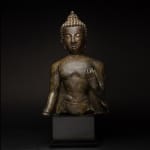Nepalese Bronze Bust of Buddha, 9th Century CE - 12th Century CE
Bronze
50.8 x 25.4 cm
20 x 10 in
20 x 10 in
HK.1
Further images
-
(View a larger image of thumbnail 1
)

-
(View a larger image of thumbnail 2
)

-
(View a larger image of thumbnail 3
)

-
(View a larger image of thumbnail 4
)

-
(View a larger image of thumbnail 5
)

-
(View a larger image of thumbnail 6
)

-
(View a larger image of thumbnail 7
)

-
(View a larger image of thumbnail 8
)

This bronze bust depicts the Buddha gracefully standing. The Buddha extends his proper right arm downward, most likely palm out, forming the varada mudra, although the hand is missing; he...
This bronze bust depicts the Buddha gracefully standing. The Buddha extends his proper right arm downward, most likely palm out, forming the varada mudra, although the hand is missing; he raises his left hand to chest height, where he grasps the edge of his garment. The smile on his face is serene and soothing. The Buddha stands in a graceful S-curve. The features are low-set on the oval face: the forehead is high and broad; the eyes wide-set, and half closed; the nose and mouth wide; the lips full and sensuous; and the chin dainty and rounded; the "ushnisha" tall, relatively narrow, and rounded on its top. Small, snail-shell curls of hair cover the Buddha's head. Three registers of curls cover the "ushnisha", with a single curl at the very top. Three intaglio rings encircle the neck, creating the fleshy folds that frequently also are described in canonical texts. The Buddha wears a "sanghati", or outer robe, which is draped, cape-like, over both shoulders; it flares out on either side of the Buddha's body as if animated by a breeze or by the Buddha's movements. The "sanghati" gathers in several overlapping rings at the neck, suggesting a collar; the folds of the "sanghati" fall elegantly over the body in a series of eight, elongated, descending parabolic arcs. The expanses of drapery that hang from the arms and flare outward. The back of the sculpture is plain and without representational details, except for the back of the head, which is rounded and covered with small, snail-shell curls of hair. Around its periphery, the sculpture's edges are lightly rounded at the shoulders and down the sides. The closely related Nepalese sculpture is in the collection of the British Museum, London: a Standing Buddha Sakyamuni whose hands are in the same position as this image and which the British Museum curators date to the ninth to tenth century (1969.4-19.1). - Danny Ching







